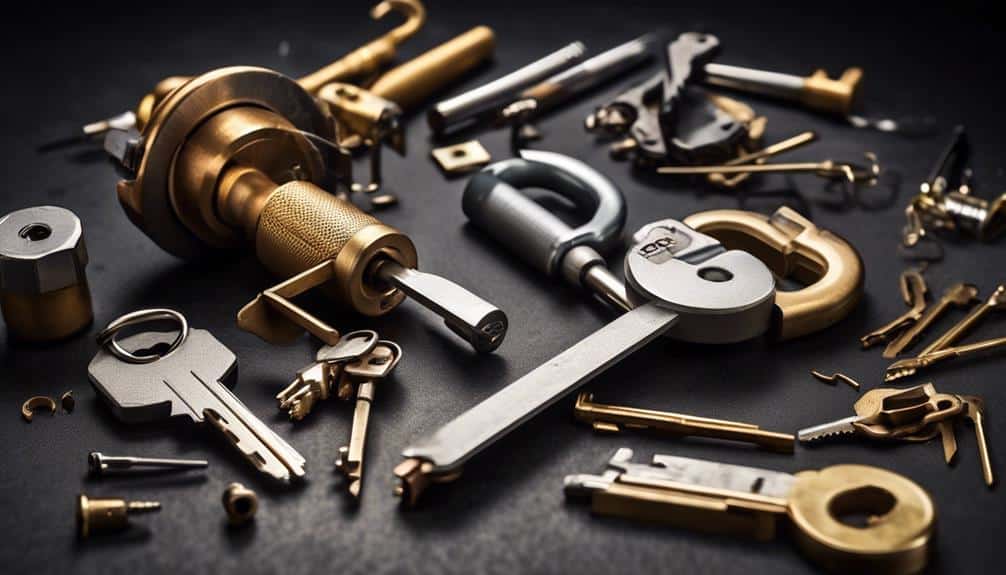Did you know that approximately 2 million burglaries occur each year in the United States? With such a staggering statistic, it's important to ensure the safety and security of our homes.
One crucial aspect of home security is the functionality of our locks. Whether it's a broken key stuck in the lock or a jammed deadbolt, emergency lock repairs can be a stressful situation. But fear not, as we've got you covered with quick fixes that can save the day.
So, if you've ever found yourself in a lock-related bind, keep reading to discover some handy tips and tricks that can help you regain access to your home swiftly and efficiently.
Common Lock Issues
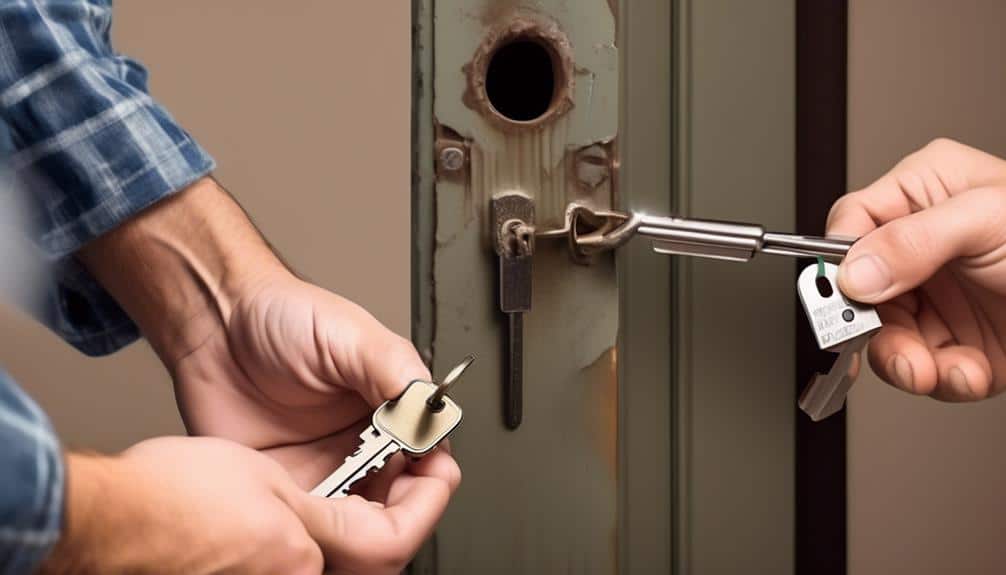
Common lock issues can cause frustration and inconvenience, but with prompt attention and the expertise of a professional locksmith, these problems can be quickly resolved. One of the main causes of lock issues is a lack of proper lock maintenance. Regular maintenance is crucial to prevent lock damage and ensure smooth operation.
One common issue is key sticking or difficulty in turning the key. This can be caused by dirt, debris, or worn-out key pins. Regular cleaning and lubrication can help prevent this problem.
Another common issue is a misaligned lock mechanism. This can occur due to frequent use or external force. A professional locksmith can realign the lock to ensure proper functioning.
Locks can also become loose over time, leading to difficulties in opening or closing doors. This can be caused by loose screws or worn-out internal parts. Regularly checking and tightening screws can prevent this issue.
Additionally, locks can suffer from wear and tear, resulting in the need for key replacement or rekeying. Regularly inspecting keys for signs of damage and replacing them when necessary can prevent lock issues.
Assessing the Lock Damage
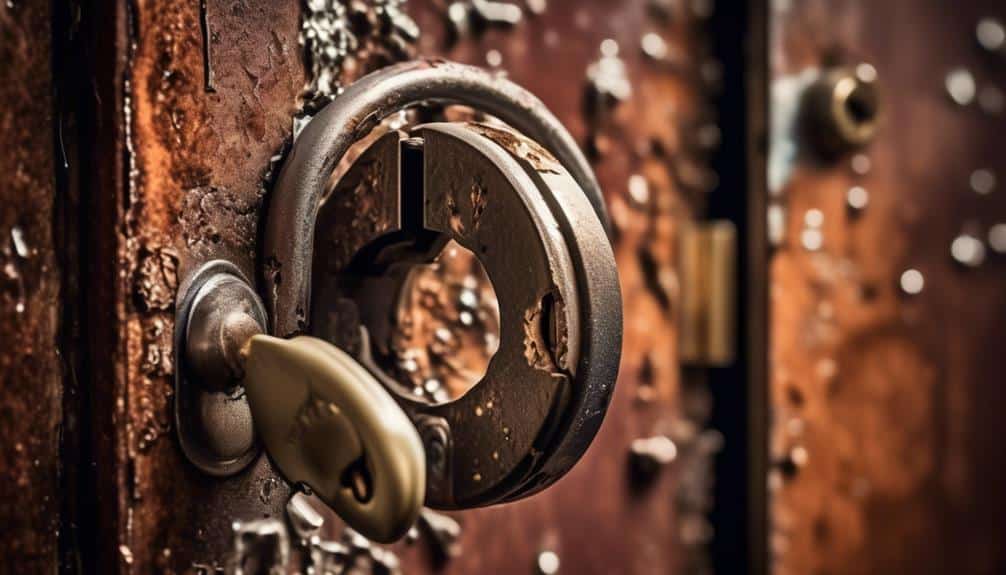
Now let's talk about assessing the damage to your lock.
There are several techniques we can use to inspect the lock and identify any common issues. By carefully examining the lock, we can determine the extent of the damage and what needs to be done for repairs.
In the meantime, we can also provide temporary lock solutions to ensure your security.
Lock Inspection Techniques
To properly assess the damage to a lock, it's essential to employ effective lock inspection techniques. By thoroughly examining the lock, you can determine the extent of the damage and identify the necessary repairs or replacements. Here are some key techniques to consider:
- Visual Inspection: Start by visually inspecting the lock for any visible signs of damage, such as bent or broken parts, loose screws, or worn-out components.
- Functional Testing: Test the lock's functionality by inserting the key and turning it to see if it smoothly operates. Additionally, check if the lock properly engages with the strike plate or latch.
- Internal Examination: If necessary, disassemble the lock to inspect the internal components for any signs of wear, corrosion, or malfunction.
Identifying Common Lock Issues
After thoroughly inspecting the lock, we can now move on to identifying common issues that may be causing the damage.
It's important to note that regular lock maintenance plays a crucial role in preventing lock damage. One common issue is a misaligned strike plate, which can occur due to loose screws or general wear and tear.
Another common problem is a worn-out key, which can lead to issues such as difficulty in turning the lock or the key getting stuck inside. Additionally, a faulty latch mechanism can cause the lock to become ineffective and prone to damage.
Temporary Lock Solutions
Inspecting the damage to the lock, we can now explore temporary solutions to address the issue.
When faced with a broken lock, it's crucial to implement quick fixes to ensure security.
Here are some temporary lock solutions that can be applied in emergency lock repair situations:
- Lubrication: Applying lubricant to the lock mechanism can help ease the movement of the key and potentially fix minor issues.
- Realigning the strike plate: If the lock isn't aligning properly, adjusting the strike plate can help improve functionality.
- Using temporary security devices: In cases where the lock is completely damaged, utilizing temporary security devices such as padlocks or door bars can provide a temporary solution while waiting for a professional locksmith.
Tools Needed for Lock Repair
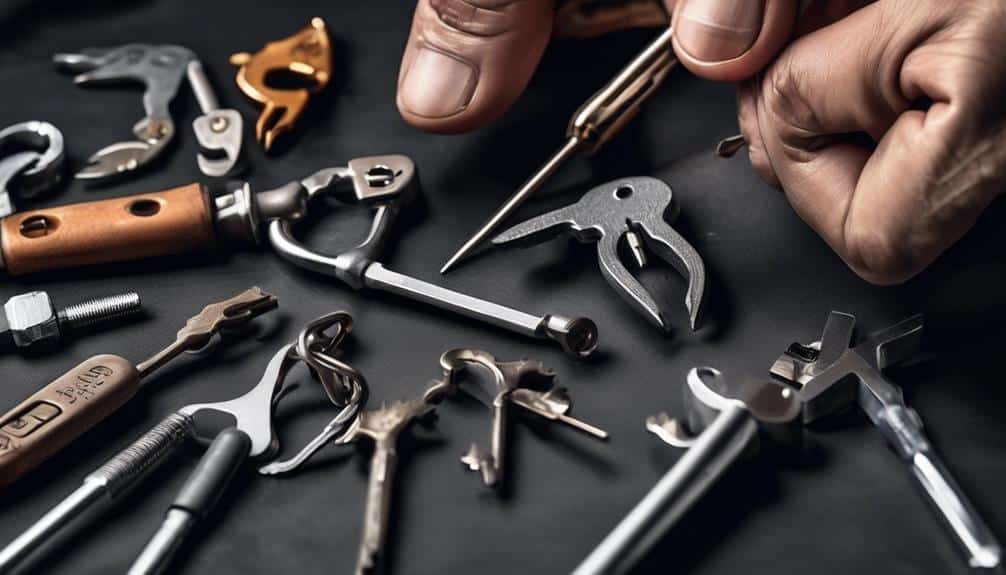
Our lock repair toolkit includes a variety of essential tools that enable us to efficiently and effectively repair locks in emergency situations. When it comes to lock repair techniques, having the right tools is crucial to ensure a successful and timely fix.
One of the most important tools in our arsenal is the lock pick set. This set includes various picks, hooks, and tension wrenches that allow us to manipulate the lock components and gain access without causing any damage.
Additionally, we always carry a key extractor tool, which is essential for removing broken keys from locks. This tool helps us extract the key without further damaging the lock, allowing us to easily replace the key or repair the lock.
Another tool we rely on is the lock lubricant. This is essential for loosening stuck or jammed lock components, making it easier to repair and restore functionality.
Lastly, we always have a sturdy pair of pliers and a screwdriver in our toolkit. These tools come in handy for removing and replacing screws, as well as for gripping and manipulating small lock parts.
With these essential lock repair tools at our disposal, we're able to quickly and effectively resolve lock emergencies.
Fixing a Broken Key in the Lock
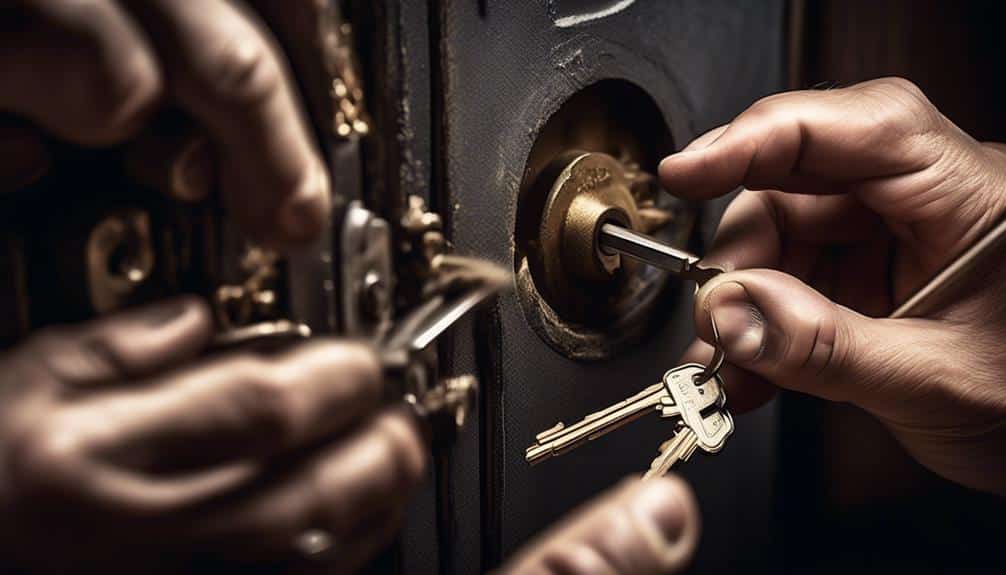
Now let's talk about fixing a broken key in the lock.
When a key breaks inside a lock, there are two main points to consider: broken key extraction and repairing the lock mechanism.
First, we need to carefully remove the broken key pieces using specialized tools.
Then, we must assess the lock mechanism for any damage caused by the broken key and repair it if necessary.
Broken Key Extraction
To fix a broken key in the lock, we can use various extraction techniques to safely remove the key remnants. Here are three effective methods for broken key extraction:
- Needle Nose Pliers: Gently insert the pliers into the lock and grip the broken key fragment. Slowly pull it out, being careful not to damage the lock mechanism.
- Super Glue: Apply a small amount of super glue to the end of a thin wire or toothpick. Carefully insert it into the lock and press it against the broken key. Wait for the glue to dry and then pull out the key fragment.
- Jigsaw Blade: Insert a jigsaw blade into the lock, with the teeth facing upwards. Wiggle the blade to catch the broken key fragment and pull it out.
Repairing Lock Mechanism
When faced with a broken key in the lock, it is crucial to promptly repair the lock mechanism using effective extraction techniques. Proper lock maintenance and troubleshooting skills are essential in resolving this issue. Here are some steps to repair a lock mechanism:
| Steps | Description |
|---|---|
| Step 1 | Assess the type of lock and determine the appropriate extraction tool. |
| Step 2 | Apply lubricant to the lock to ease the removal of the broken key. |
| Step 3 | Insert the extraction tool into the lock and gently maneuver it to hook onto the key. |
| Step 4 | Slowly pull out the broken key, making sure to keep it aligned with the lock's keyway. |
| Step 5 | Test the lock with a spare key to ensure it functions properly.
Repairing a Jammed Lock
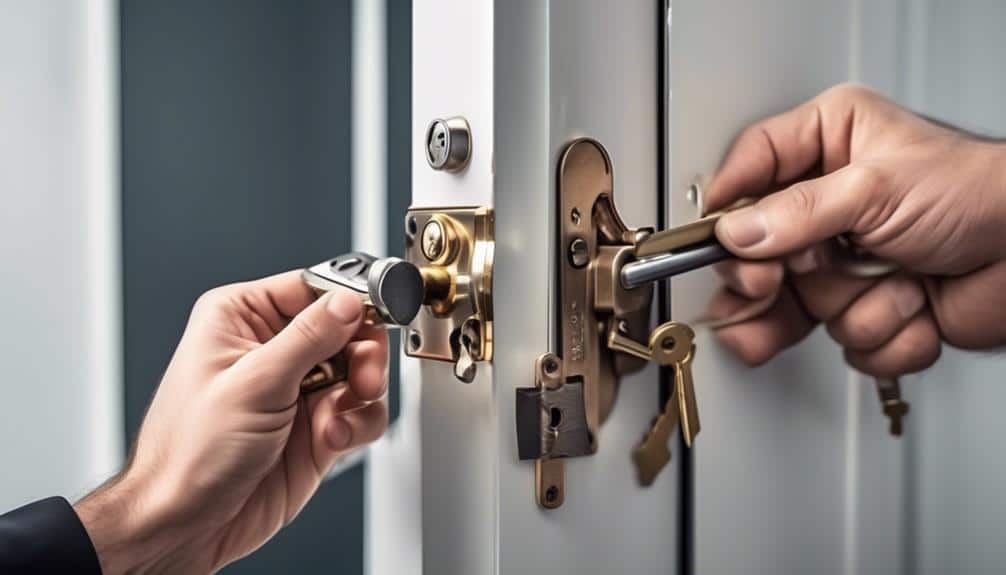
If your lock is jammed, there are several steps you can take to repair it efficiently and effectively.
First, try using lock lubrication to loosen any stuck components. Apply a small amount of graphite powder or silicone spray directly into the lock mechanism. This will help reduce friction and allow the lock to move more freely.
If lubrication doesn't solve the problem, the next step is to check for any visible obstructions. Inspect the keyway and lock mechanism for debris or foreign objects that may be causing the jamming. Use a small, pointed tool or a pair of tweezers to carefully remove any obstructions.
If the lock remains jammed after lubrication and removal of obstructions, it may be time to seek professional locksmith assistance. A skilled locksmith will have the necessary tools and expertise to diagnose and repair the issue. They can disassemble the lock, identify the root cause of the jamming, and either repair or replace the affected components.
Replacing a Faulty Lock Cylinder
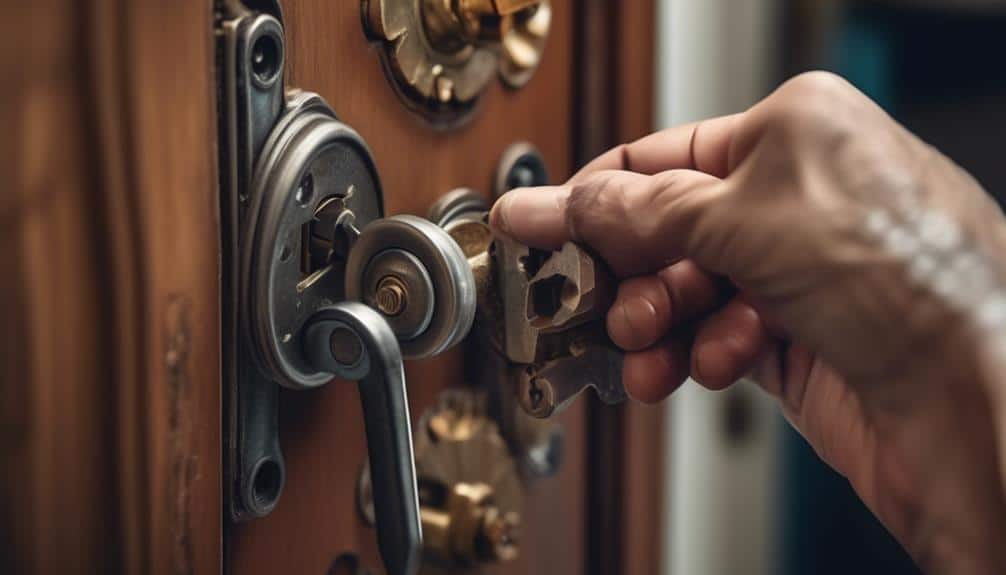
After attempting to repair a jammed lock, if the issue persists, the next step is to replace the faulty lock cylinder. Lock cylinder replacement is a common solution for locks that are beyond repair or have suffered irreparable damage.
When replacing a lock cylinder, it's important to follow proper installation techniques to ensure the lock functions correctly and provides adequate security.
To begin the lock cylinder replacement process, you'll need a replacement lock cylinder that matches the brand and model of your existing lock. Start by removing the screws that secure the lock cylinder to the door. Once the screws are removed, carefully slide out the old lock cylinder from the lock body.
Next, insert the new lock cylinder into the lock body, making sure it aligns properly with the keyway. Use the screws provided with the replacement lock cylinder to secure it in place. Make sure the lock cylinder is snug and doesn't wiggle or move.
Fixing a Loose or Misaligned Lock
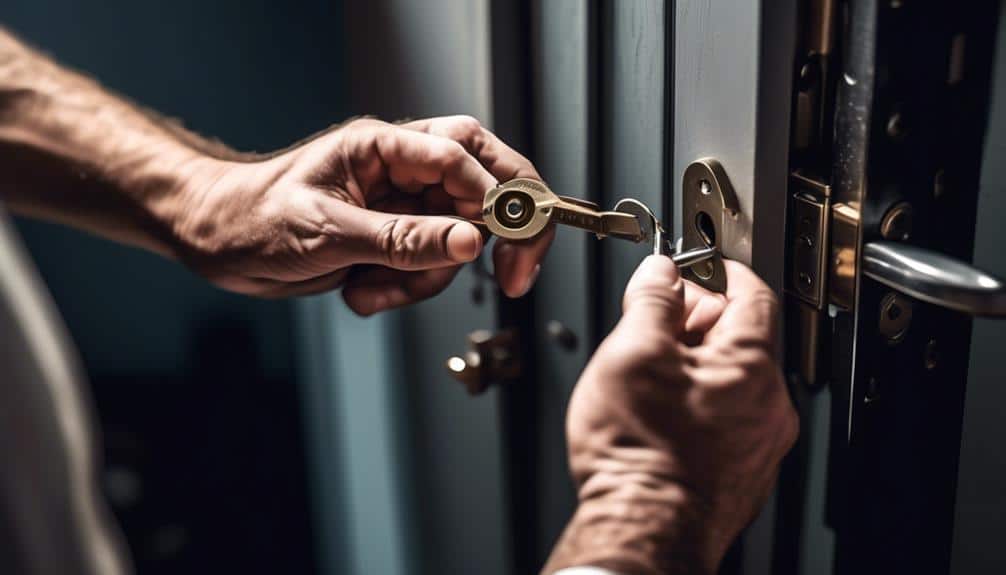
To address a loose or misaligned lock, it's important to assess the cause of the problem and determine the appropriate solution. Here are some steps to help you fix a loose or misaligned lock:
- Inspect the lock components: Carefully examine the lock to identify any loose or misaligned parts. Look for screws that may have come loose or shifted out of place.
- Tighten loose screws: Using a screwdriver, tighten any loose screws that you find. Be careful not to overtighten, as this could cause damage to the lock or strip the screws.
- Realign lock components: If the lock is misaligned, you may need to realign the components. This can usually be done by loosening the screws holding the lock in place, adjusting the position of the lock, and then tightening the screws again.
Repairing a Stuck Deadbolt
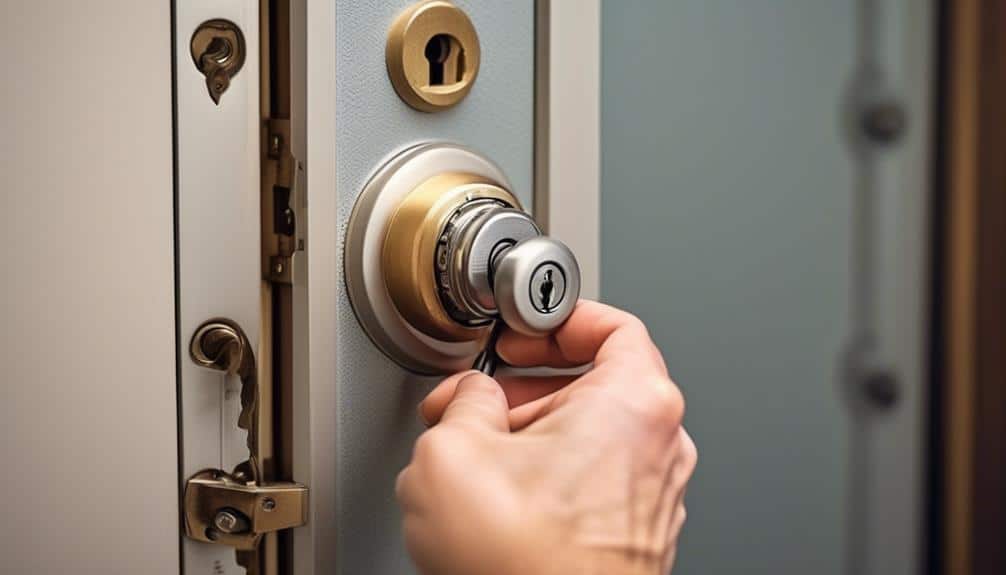
After fixing a loose or misaligned lock, the next subtopic we'll cover is repairing a stuck deadbolt. When a deadbolt gets stuck, it can be frustrating and inconvenient. However, with a little troubleshooting and some lock lubrication, you can easily fix the issue.
First, check if there's any debris or dirt in the deadbolt mechanism. Use a flashlight to inspect the bolt and its surrounding area. If you notice any buildup, gently clean it using a soft brush or compressed air.
Next, apply a lubricant specifically designed for locks. Spray or apply a small amount of lubricant to the bolt, latch, and other moving parts. This will help to reduce friction and allow the deadbolt to move smoothly.
If the deadbolt still doesn't budge, try inserting the key and gently turning it while applying slight pressure to the door. This can help to release any internal components that may be causing the deadbolt to stick.
If these steps don't solve the problem, it's best to seek professional help from a locksmith.
Emergency Lock Repair Tips

In case of an emergency lock repair, it's important to have some handy tips to quickly address the situation. Here are some key tips to keep in mind:
- Use the right tools: Having the right emergency lock repair tools can make a significant difference in resolving the issue quickly. Tools such as a lock pick set, tension wrench, and lubricant can help you fix the lock efficiently.
- Contact emergency lock repair services: If you're uncertain about how to handle the lock repair or if the situation seems complex, it's advisable to contact professional emergency lock repair services. They've the expertise and experience to handle a wide range of lock issues effectively.
- Take preventative measures: To avoid future lock emergencies, it's essential to take preventative measures. Regularly lubricating your locks and ensuring they're properly maintained can go a long way in preventing lock failures.
Frequently Asked Questions
How Much Does It Typically Cost to Hire a Locksmith for Emergency Lock Repairs?
Typically, the cost range for hiring a locksmith for emergency lock repairs can vary depending on several factors. These factors include the complexity of the lock issue, the time of day or night, and the location.
It's important to note that emergency services may incur additional charges compared to regular locksmith services. To get an accurate cost estimate, it's best to contact local locksmiths and provide them with specific details about the lock repair situation.
Are There Any Temporary Solutions to Fix a Broken Lock Until a Professional Can Arrive?
Temporary lock repair methods can be useful in emergency situations when you need to fix a broken lock quickly. DIY lock repair tips can provide temporary solutions until a professional locksmith can arrive.
These methods may include using lubricant to loosen stuck locks, using a credit card to try and open a locked door, or using a temporary replacement lock until a permanent fix can be made.
It's important to remember that these are temporary solutions and it's always best to consult a professional for a permanent fix.
Can I Use Household Items as Makeshift Lock Repair Tools in an Emergency?
In a pinch, we can get resourceful and MacGyver our way through a lock emergency using household items as makeshift repair tools. However, it's important to note that these alternative methods should only be seen as temporary solutions until a professional can arrive.
While it may be tempting to try and fix the lock ourselves, it's best to leave it in the hands of a trained locksmith who's the expertise and proper tools to ensure a safe and effective repair.
What Are the Signs That Indicate a Lock Should Be Replaced Rather Than Repaired?
When it comes to lock replacement signs, there are a few key indicators that suggest a lock should be replaced rather than repaired. These signs of irreparable locks can include:
- Excessive wear and tear
- Frequent malfunctions
- Damage that compromises the lock's security
It's important to pay attention to these signs to ensure the safety and security of your property.
Are There Any Safety Precautions I Should Take Before Attempting to Fix a Lock Myself in an Emergency Situation?
Before attempting to fix a lock ourselves in an emergency situation, we should always prioritize safety precautions.
It's crucial to ensure that we have the necessary tools and protective gear, such as gloves and safety glasses.
Additionally, we should be aware of potential hazards, such as sharp edges or electrical components, and take appropriate measures to avoid accidents.

